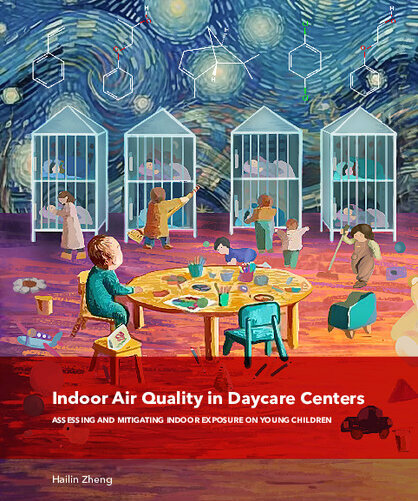Assessing and improving indoor air quality in daycare centers
Hailin Zheng defended his PhD thesis at the Department of Built Environment on May 7th.
![[Translate to English:] [Translate to English:]](https://assets.w3.tue.nl/w/fileadmin/_processed_/5/4/csm_Zheng_Hailin_BE_VH_7681_PROM_3395b9afa0.jpg)
Children are our future, and their health and development are paramount. This is especially true in their early years when they can spend up to 11 hours per day, five days a week, in daycare centers, which are the places where most children start key conitice, physical, and social developments. A less visible aspect of these indoor environments that demands urgent attention is the quality of the indoor air our young ones breathe. For his PhD research Hailin Zheng focused on how to ensure that the air in daycare centers is as clean and safe as possible.
Did you know that adults breathe in around 23,000 times a day, while infants and toddlers take in the air almost 50,000 times per day? Given their higher breathing rate, coupled with their proportionally larger breathing volume relative to body weight, and that they are still developing physically, children are much more susceptible to the harmful effects of poor indoor air quality (IAQ). This makes the indoor air quality (IAQ) in daycare centers (DCCs) a matter of serious concern.
As part of his PhD research, Hailin Zheng explored the key techniques and approaches needed to measure the quality of air in indoor settings, such as those experienced by children in daycare centers.
First step
The first step taken by Zheng related to effective monitoring, as recommended by the World Health Organization. Zheng evaluated low-cost air quality monitoring devices within DCC settings, comparing their performance against more sophisticated instruments.
The results were promising: these affordable devices can indeed help to monitor the air children breathe, and detected spikes in pollution from common indoor activities such as arts and crafts or cleaning. It underscores the need to employ multi-parameter sensors (such as Particulate Matter [PM], CO2, and total Volatile Organic Compounds [TVOC]) simultaneously to effectively monitor IAQ conditions, moving beyond reliance on single-parameter sensors like CO2 or PM sensors in current practice.

Fingerprint emissions
Further delving into the issue of indoor pollutants, Zheng’s research explored the presence and health risks of volatile organic compounds (VOCs), which can be emitted by everyday materials used in DCCs.
Common DCC activities such as painting, gluing, modeling, cleaning, and during interactions with materials such as mattresses, have unique VOC 'fingerprint' emissions.
For example, Zheng’s work found significant differences in VOC levels when using different cleaning products for tables. It also underscores the importance of regular check-ups and replacements of mattresses to mitigate VOC exposure during nap times for children. By identifying these VOC emissions, safer products and practices can be selected, significantly reducing children's exposure to harmful chemicals.
Concern with sleeping areas
A particular concern in DCCs is the ventilation around sleeping areas, especially in the Dutch and Belgian contexts where semi-enclosed baby beds are common. Infants and toddlers need clean air as they sleep to thrive and grow, but Zheng’s findings show that current ventilation practices fall short.
Through detailed full-scale experiments, Zheng explored different ventilation strategies to find more effective solutions. Specifically, his study advocates for a shift in focus towards inhaled air quality, suggesting personalized ventilation strategies as a promising solution with the potential of energy saving. This can ensure clean air reaches every sleeping child inside the semi-enclosed baby beds.
Overall, Zheng’s PhD reseach proposes the use of evidence-based strategies including low-cost multi-parameter monitoring, mindful material choices, and tailored ventilation strategies to create healthier environments for young children in DCCs.
This lays the groundwork for future IAQ research focused on the actual air breathed by occupants.
Let's breathe easier, knowing our children do this as well.
Title of PhD thesis: Indoor Air Quality in Daycare Centers: Assessing and Mitigating Indoor Exposure on Young Children. Supervisors: Twan van Hooff, Marcel Loomans, and Shalika Walker.